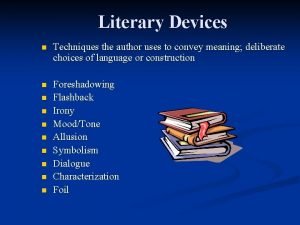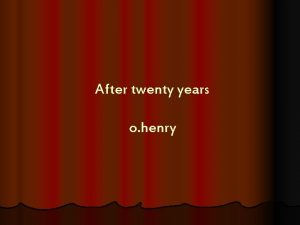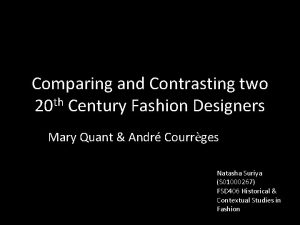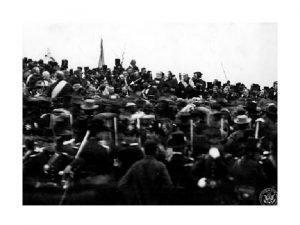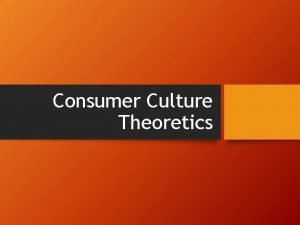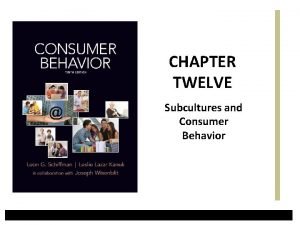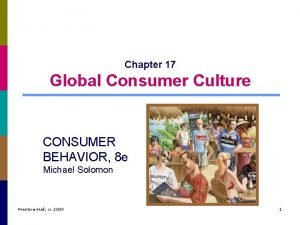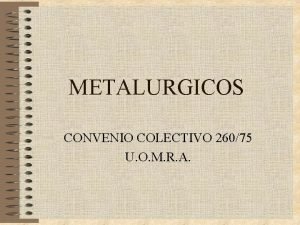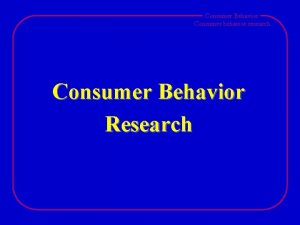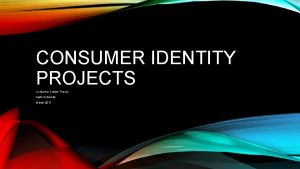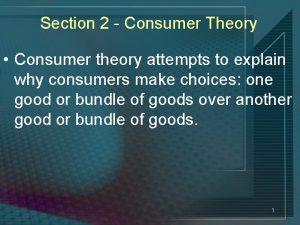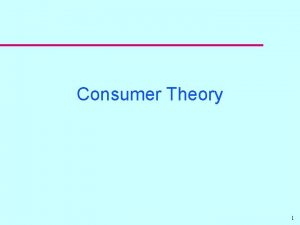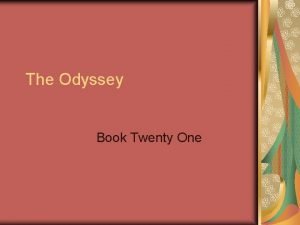CONSUMER CULTURE THEORY CCT TWENTY YEARS OF RESEARCH
























- Slides: 24

CONSUMER CULTURE THEORY (CCT): TWENTY YEARS OF RESEARCH JCR 2005 Eric J. Arnould, Craig T. Thompson

OUTLINE • The paper has three goals. What are they? • What kind of consumer research is CCT? • The paper concludes with directions for future research within CCT.

OUTLINE • What kind of consumer research is CCT? • Research addressing the socio-cultural, experiential, symbolic, and ideological aspects of consumption. • The paper has three goals. What are they? • Demythologizing key misconceptions about this research tradition • Providing a viable disciplinary brand for this research • Systematizing current research within CCT • The paper concludes with directions for future research within CCT.

LAUDAN’S RETICULATED MODEL OF THE DEVELOPMENT OF RESEARCH TRADITIONS The paper takes a turn towards philosophy of science concerns. Why? Aims RT 1 Theoretical interests Epistemology; Methods Aims RT 2 Theoretical interests Epistemology; Methods

THE PREPARADIGMATIC FIELD C. 1980 Hegelian theory, Semiotics, feminism, design theory, narrative psychology, deductive sociology, literary criticism, Marxist critical thinking Emic. Humanistic. Ethnograph ic discourse Disparate Discursive Elements Emergent Discursive system

DISCIPLINARY BRANDING • CCT: An emergent theoretical program that fulfills calls for a science of consumer behavior • Why or how does this research program fulfill that call? • What kind of science? • Consumer research addressing the socio-cultural, experiential, symbolic, and ideological aspects of consumption • What gap does this fill? • Consumer culture is the central construct • What is culture? Why focus on culture?

SYSTEMATIZING: MOMENTS AND LEVELS • What are the “moments” of the consumption cycle? • What levels of analysis of consumption processes should be distinguished? • How many ways could we decode this photograph?

SYSTEMATIZING: MOMENTS AND LEVELS • What are the “moments” of the consumption cycle? • • Acquisition: gift giving Consumption: subject-object relationships Disposition: identity and role transformations Production: proactive consumer • What levels of analysis of consumption processes should be distinguished? • Micro • Meso • Macro

DOMAIN OF CONSUMER BEHAVIOR Acquiring Individuals or Groups receiving finding inheriting producing learning deciding purchasing Using PRODUCTS SERVICES IDEAS EXPERIENCES collecting nurturing cleaning preparing Disposing displaying storing wearing sharing selling giving throwing away recycling depleting

CULTURE • Culture is a symbolic system in which we are all emmeshed. • It orders reality into frameworks (variable in time and space) that humans can understand. • Consequntly, it establishes the scaffolding through which meaningful individual and group activities can take place. • Culture is embodied in part in the human spirit (variable in time and space) and in the operation of a group which imposes this scaffolding on its members. • In part, culture is embodied in objects themselves that incorporate a symbolic system that was imposed upon them at their creation and develops in the course of circulation and use.

CONSUMER CULTURE: DEFINITIONS • Consumer culture is a social arrangement in which the relation between lived experience and social resources, between meaningful ways of life and the symbolic and material resources on which they depend, is mediated through markets. Marketize d resources Consumpti on meanings, routines, identities, values,

CONSUMER CULTURE: DEFINITIONS • The reproduction of the global market system is largely understood to be carried out through the exercise of free personal consumer choice in the private sphere of everyday life (Slater 1997, 8). Marketize d resources Consumer actions, communic ations, customizat ions, routines, rituals

THE VARIABLE MEANING OF THINGS Who Rides The Bajaj Saffir? Where does Coca Cola come from?

SYSTEMATIZING: FOUR RESEARCH PROGRAMS • Consumer Identity Projects • Marketplace Cultures • The Socio-historic Patterning of Consumption • Mass-Mediated Marketplace Ideologies and Consumers’ Interpretive Strategies

CONSUMER IDENTITY PROJECTS • What is the key question driving this program of research? • What does it mean to be, in the full ontological sense of the term, a consumer? • CCT is concerned with the co-constitutive, co-productive ways in which consumers, working with marketer-generated materials forge a coherent, if diversified and sometimes fragmented sense of self • Consumers are conceived of as identity makers. • The study of consumer identity projects meshes quite well with consumer research’s more traditional interest in consumer goals and motives

EXAMPLE • In his work, Schouten 1992 showed through the surgical disposition of one physical attribute and the acquisition of another a person may symbolically shed one identity in favor of another • In their work on digital selfpresentation Schau and Gilly (2003) show consumers use brands and hyperlinks to create multiple, non-linear cyber identities.

MARKETPLACE CULTURES • What is the key research question driving this program of research? • How does the emergence of consumption as a dominant human practice reconfigure the foundations of culture, and vice versa? • The consumer is conceived of as a culture producer. • CCT explores the heterogeneous distribution of meanings and the multiplicity of overlapping cultural groupings that exist within the broader socio-historic frame of globalization and market capitalism. This distributed view of cultural emphasizes the dynamics of fragmentation, plurality, fluidity, and the intermingling (or hybridization) of cultural traditions and ways of life

EXAMPLE • In his foundational work, Hebdige (1979) showed how subcultural consumption exhibits an ongoing structured opposition to dominant culture as well as internal oppositions between socially approved behaviors and negatively sanctioned stereotypes • Kates (2002) showed subcultural consumption is a sort of ongoing socialization process, and conspicuously conscious. Further, status is achieved not through adherence to monolithic consumption norms, but through the combinatorial inventiveness and semiotic playfulness.

THE SOCIO-HISTORIC PATTERNING OF CONSUMPTION • What is the key research question driving the third dimension of CCT research? • The dominant research problem is what is consumer society? • This research addresses the reciprocal relationships between institutional and social structures that systematically influence consumption and consumers’ experiences, belief systems and practices that mold these underlying institutional and social structures. • These “structures” include social categories of age, gender, status, race, religion, and so on. • Consumers are conceived of as enactors of social roles and positions.

EXAMPLE • Allen’s (2002) research on the socio-historic patterning of working class consumers’ choices and, and concomitant social immobility, tends to reproduce patterns and orientations grounded in respective socialization histories. • Work by a large number of colleagues has enabled us to outline a nuanced model of what Cheal referred to as the moral economy of gift exchange in terms of modalities of expressive love, goals and motivations, and social categories.

MASS-MEDIATED MARKETPLACE IDEOLOGIES AND CONSUMERS’ INTERPRETIVE • What are the fundamental questions guiding this fourth CCT research program? STRATEGIES • What normative messages do commercial media transmit about consumption? • How do regimes of consumption become legitimate? • How do consumers’ make sense of consumption norms and also formulate critical responses? • The concept of ideology and consumers’ relationships to ideological influences is thus a fourth current of CCT research. • Consumers are conceived of as interpretive agents.

EXAMPLE • Kozinets and Handelman (2004) develop understanding of new consumer activist movements that ironically are linked to evangelical religious traditions. These movements seek to change the ideology of consumerism through transformations both in corporate and consumer behaviors. It notes the parallels with religious evangelism. Their approach contrasts with prior theory on consumer activism that construes it as concerned primarily with functional change in corporate behaviors or the venting of frustration.

DEMYTHOLOGIZING Identifying the gap in understanding • Myth 1: Consumer culture theorists study contexts as ends in themselves. • Myth 2: The primary differences between CCT and other research approaches are methodological. • Myth 3: CCT research is a sphere of creative expression, voyeurism, esoterica, and sonorous introspection of limited relevance to the broader theory of consumption, and the concerns of managers and public policy makers.

CONCLUSION • CCT is a complex effort to systematically link individual level (or idiographic) meanings to different levels of cultural processes and social structures and to situate these relationships within historical and marketplace contexts. • CCT is premised on the notion that consumption is a historically shaped mode of socio-cultural practice that emerges within the structures and ideological imperatives of the market economy. • CCT brings theory back not only to specific cultural experiences and identifications that are relevant to consumers lives but it continually investigates how consumption and ways of being a consumer are shaped by marketplace structures.
 Consumer culture theory (cct): twenty years of research
Consumer culture theory (cct): twenty years of research What is a secondary consumer in a food chain
What is a secondary consumer in a food chain Consumer research process
Consumer research process Irony in harrison bergeron
Irony in harrison bergeron Four score and twenty years ago
Four score and twenty years ago O henry after twenty years summary
O henry after twenty years summary Compare and contrast fashion today with twenty years ago
Compare and contrast fashion today with twenty years ago Twenty years before
Twenty years before How long is four score and seven years
How long is four score and seven years Sammy toyoki
Sammy toyoki Goat years to human years
Goat years to human years 300 solar years to lunar years
300 solar years to lunar years Desert herbivore
Desert herbivore Cengage
Cengage Characteristics of consumer behaviour
Characteristics of consumer behaviour Consumer markets and consumer buyer behavior
Consumer markets and consumer buyer behavior Global consumer culture positioning example
Global consumer culture positioning example Global segmentation targeting and positioning
Global segmentation targeting and positioning Global consumer culture positioning example
Global consumer culture positioning example Global consumer culture positioning example
Global consumer culture positioning example What is consumer culture
What is consumer culture What are subculture examples
What are subculture examples Cultural formulae
Cultural formulae Qualiroute
Qualiroute Cct 260/75
Cct 260/75



